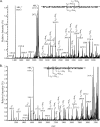Modification of Pseudomonas aeruginosa Pa5196 type IV Pilins at multiple sites with D-Araf by a novel GT-C family Arabinosyltransferase, TfpW
- PMID: 18805982
- PMCID: PMC2576659
- DOI: 10.1128/JB.01075-08
Modification of Pseudomonas aeruginosa Pa5196 type IV Pilins at multiple sites with D-Araf by a novel GT-C family Arabinosyltransferase, TfpW
Abstract
Pseudomonas aeruginosa Pa5196 produces type IV pilins modified with unusual alpha1,5-linked d-arabinofuranose (alpha1,5-D-Araf) glycans, identical to those in the lipoarabinomannan and arabinogalactan cell wall polymers from Mycobacterium spp. In this work, we identify a second strain of P. aeruginosa, PA7, capable of expressing arabinosylated pilins and use a combination of site-directed mutagenesis, electrospray ionization mass spectrometry (MS), and electron transfer dissociation MS to identify the exact sites and extent of pilin modification in strain Pa5196. Unlike previously characterized type IV pilins that are glycosylated at a single position, those from strain Pa5196 were modified at multiple sites, with modifications of alphabeta-loop residues Thr64 and Thr66 being important for normal pilus assembly. Trisaccharides of alpha1,5-D-Araf were the principal modifications at Thr64 and Thr66, with additional mono- and disaccharides identified on Ser residues within the antiparallel beta sheet region of the pilin. TfpW was hypothesized to encode the pilin glycosyltransferase based on its genetic linkage to the pilin, weak similarity to membrane-bound GT-C family glycosyltransferases (which include the Mycobacterium arabinosyltransferases EmbA/B/C), and the presence of characteristic motifs. Loss of TfpW or mutation of key residues within the signature GT-C glycosyltransferase motif completely abrogated pilin glycosylation, confirming its involvement in this process. A Pa5196 pilA mutant complemented with other Pseudomonas pilins containing potential sites of modification expressed nonglycosylated pilins, showing that TfpW's pilin substrate specificity is restricted. TfpW is the prototype of a new type IV pilin posttranslational modification system and the first reported gram-negative member of the GT-C glycosyltransferase family.
Figures











Similar articles
-
Glycosylation of Pseudomonas aeruginosa strain Pa5196 type IV pilins with mycobacterium-like alpha-1,5-linked d-Araf oligosaccharides.J Bacteriol. 2007 Jan;189(1):151-9. doi: 10.1128/JB.01224-06. Epub 2006 Nov 3. J Bacteriol. 2007. PMID: 17085575 Free PMC article.
-
Pseudomonas aeruginosa D-arabinofuranose biosynthetic pathway and its role in type IV pilus assembly.J Biol Chem. 2011 Aug 12;286(32):28128-37. doi: 10.1074/jbc.M111.255794. Epub 2011 Jun 15. J Biol Chem. 2011. PMID: 21676874 Free PMC article.
-
Structural characterization of novel Pseudomonas aeruginosa type IV pilins.J Mol Biol. 2010 Jan 22;395(3):491-503. doi: 10.1016/j.jmb.2009.10.070. Epub 2009 Nov 4. J Mol Biol. 2010. PMID: 19895819
-
Archaeal flagella, bacterial flagella and type IV pili: a comparison of genes and posttranslational modifications.J Mol Microbiol Biotechnol. 2006;11(3-5):167-91. doi: 10.1159/000094053. J Mol Microbiol Biotechnol. 2006. PMID: 16983194 Review.
-
Posttranslational processing of type IV prepilin and homologs by PilD of Pseudomonas aeruginosa.Methods Enzymol. 1994;235:527-40. doi: 10.1016/0076-6879(94)35168-6. Methods Enzymol. 1994. PMID: 8057924 Review.
Cited by
-
Protein O-linked glycosylation in the plant pathogen Ralstonia solanacearum.Glycobiology. 2016 Mar;26(3):301-11. doi: 10.1093/glycob/cwv098. Epub 2015 Nov 3. Glycobiology. 2016. PMID: 26531228 Free PMC article.
-
Type IV Pilus Alignment Subcomplex Proteins PilN and PilO Form Homo- and Heterodimers in Vivo.J Biol Chem. 2016 Sep 16;291(38):19923-38. doi: 10.1074/jbc.M116.738377. Epub 2016 Jul 29. J Biol Chem. 2016. PMID: 27474743 Free PMC article.
-
Spread of Pseudomonas aeruginosa ST274 Clone in Different Niches: Resistome, Virulome, and Phylogenetic Relationship.Antibiotics (Basel). 2023 Oct 24;12(11):1561. doi: 10.3390/antibiotics12111561. Antibiotics (Basel). 2023. PMID: 37998763 Free PMC article.
-
Protein glycosylation in bacteria: sweeter than ever.Nat Rev Microbiol. 2010 Nov;8(11):765-78. doi: 10.1038/nrmicro2383. Nat Rev Microbiol. 2010. PMID: 20948550 Review.
-
Sculpting the Bacterial O-Glycoproteome: Functional Analyses of Orthologous Oligosaccharyltransferases with Diverse Targeting Specificities.mBio. 2022 Jun 28;13(3):e0379721. doi: 10.1128/mbio.03797-21. Epub 2022 Apr 26. mBio. 2022. PMID: 35471082 Free PMC article.
References
-
- Aas, F. E., W. Egge-Jacobsen, H. C. Winther-Larsen, C. Lovold, P. G. Hitchen, A. Dell, and M. Koomey. 2006. Neisseria gonorrhoeae type IV pili undergo multisite, hierarchical modifications with phosphoethanolamine and phosphocholine requiring an enzyme structurally related to lipopolysaccharide phosphoethanolamine transferases. J. Biol. Chem. 28127712-27723. - PubMed
-
- Altschul, S. F., W. Gish, W. Miller, E. W. Myers, and D. J. Lipman. 1990. Basic local alignment search tool. J. Mol. Biol. 215403-410. - PubMed
Publication types
MeSH terms
Substances
LinkOut - more resources
Full Text Sources
Miscellaneous

